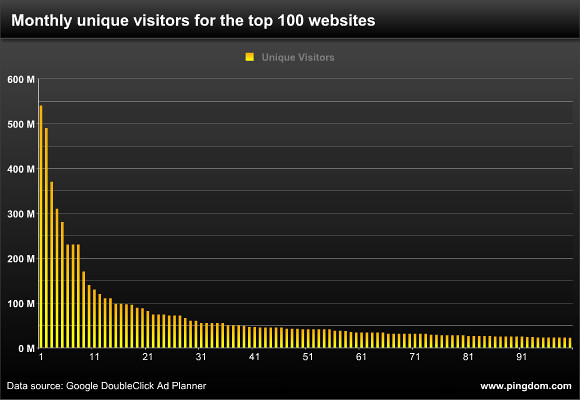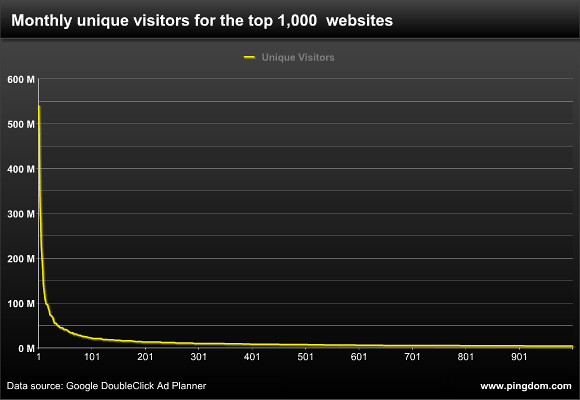
Everyone knows that the really big and popular websites have a ton of visitors. But how many? How much does it take to reach the top?
We were curious about this ourselves. We’ve all seen the almost absurd numbers involved with the very top sites (like Facebook), but what about website number 50, or 100, or 500? What does it take for a website, in terms of visitors, to reach such a ranking?
A while back Google released a list of the 1,000 most-visited websites on the Internet, including estimates of how many worldwide visitors those websites have each month. We used this list as a basis for this little study.
Key findings
There are some very revealing patterns that emerge when you look at this many websites at once, but before we go ahead and show you those, here are a few key findings:
- To become a top 1,000 website you need at least 4.1 million visitors per month.
- To become a top 500 website you need at least 7.4 million visitors per month.
- To become a top 100 website you need at least 22 million visitors per month.
- To become a top 50 website you need at least 41 million visitors per month.
- To become a top 10 website you need at least 230 million visitors per month.
- To become the number 1 website in the world? Then you need more than 540 million visitors per month. (Good luck with that.)
Facebook is the site behind that last number.
And just to be clear, whenever we say “visitors” in this article, we mean unique visitors.
The visitor numbers for the top websites
To give you a good overview how the visitor numbers are distributed over the top websites, we have created two charts for you. One shows the top 100 websites, and one shows the top 1,000. Each chart shows the number of visitors these websites receive per month.
Here’s the first one, the top 100 websites:

As you can see, a clear pattern emerges, with a sharp increase in visitor numbers for the very top websites, and the curve flattening out more and more the longer down the list you go. The number of visitors websites receive is clearly very much a case of the famous “long tail”.
The long tail becomes even more obvious when you expend the scope to show the top 1,000 websites:

Above: At this scale columns just look messy, so we used a line graph.
The effect of the long tail
What the above charts show is very much an example of “the long tail” in terms website visitors.
If you sum up the number of visitors each website receives, you get very telling ratios when you compare the top 10, top 100 and top 1,000.
- The top 10 websites get 42% of the visitors to the top 100, and 21% of the visitors to the top 1,000.
- The top 100 gets 50% of the visitors to the top 1,000. I.e. the top 100 together get as many visitors as the following 900 websites counted together.
Visitor numbers are a bit special in that there of course will be be plenty of overlap between the websites. After all, we web users tend to visit more than one site. This overlap will be bigger the higher up in the rankings you go.
Final words
So there you have it. If you want to break into the top 100 websites, you’ll need at least 22 million visitors per month. If you “only” aim for the top 1,000, you’ll need at least 4.1 million visitors per month.
Gee, that can’t be so hard, can it…?
A note about the data:
This data comes from Google, which in turn uses both its own data and that of third parties to calculate these estimates (and they ARE estimates).
One interesting bit about this is that Google tends to exclude most of its own properties/sites from such lists, so the charts above did not include the numbers for Google Search and YouTube, to name a couple of prominent examples. We adjusted the “what it takes to be a top 10 site” number to take this into consideration, since we know that both Google Search and YouTube are top 10 sites. The charts, however, don’t include these sites since we don’t have comparable visitor numbers for them.
That said, even with a few site omissions from Google, the overall results should give you a good indication of what it takes, in terms of visitor numbers, to be counted among the top sites of the world.


























